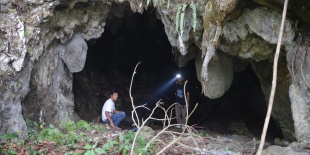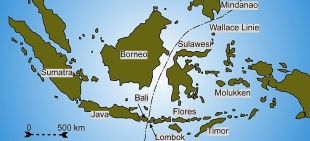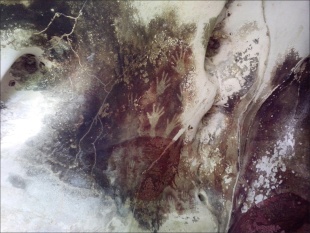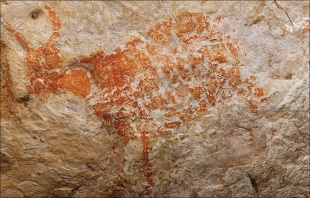BOAT TRAVEL AND THE EARLY PEOPLE IN INDONESIA
It is widely accepted in palenotology circles that people were living in Australia at least 55,000 years ago. New Guinea was first settled about 40,000 years ago, around the same times as Australia. One could easily assume that people were living in Indonesia before this time because likely people traveled through Indonesia to get to Australia and New Guinea.
Earliest Evidence of of Modern Humans in Indonesia
Country — Date — Place — Notes
Indonesia —63,000-73,000 years before present — Lida Ajer cave — Teeth found in Sumatra in the 19th century
Borneo — 46,000 years before present — Niah Cave, Malaysia — A human skull in Sarawak, Borneo (Archaeologists have claimed a much earlier date for stone tools found in the Mansuli valley, near Lahad Datu in Sabah, but precise dating analysis has not yet been published.)
New Guinea — 40,000 years before present — Indonesian Side of New Guinea — Archaeological evidence shows that 40,000 years ago, some of the first farmers came to New Guinea from the South-East Asian Peninsula. [Source: Wikipedia +]
Evidence of human habitation, estimated at around 33,000 year old, has also been found at Golo and Wetef Island (northwest of New Guinea), coastal Sulawesi, the northern coast of New Guinea, the Bismark Archipelago (northeast of New Guinea), and the northern Solomon Islands (southeast of New Guinea), Stone tools and shells dated to 11,000 B.C. found north of Medan along the Strait of Malacca. In the northern Maluku and Papua region, there is evidence of long-distance trade (for example, in obsidian, used for making cutting tools), deliberate horticulture, and the transport of plants (bananas, taro, palms) and animals (wallabies, flying squirrels) used as food sources between 20,000 and about 9,000 years ago. Possibly these communities also used sails and outriggers on their boats to make them seaworthy.
RELATED ARTICLES:
JAVA MAN AND HOMO ERECTUS IN INDONESIA factsanddetails.com
HOMO FLORESIENSIS: HOBBITS OF INDONESIA factsanddetails.com
ORIGINS AND ANCESTORS OF HOMO FLORESIENSIS (HOBBITS) factsanddetails.com
EARLY HUMANS IN SULAWESI, INDONESIA AND THEIR 45,000-YEAR-OLD CAVE ART factsanddetails.com
EARLY HUMANS IN BORNEO: NIAH CAVES 40,000-YEAR-OLD ROCK ART factsanddetails.com
EAST TIMOR — HOME OF THE WORLD’S FIRST DEEP SEA FISHERMEN factsanddetails.com
EARLIEST PEOPLE OF INDONESIA: NEGRITOS, PROTO-MALAYS, MALAYS AND AUSTRONESIAN SPEAKERS factsanddetails.com
OLDEST CULTURES IN INDONESIA AND PEOPLE THERE BEGINNING 10,000 YEARS AGO factsanddetails.com
First Humans in Sumatra 70,000 Years Ago
Modern humans were in Sumatra at least 70,000 years. In a study published in Nature in August 2017, scientists said they had accurately dated two human teeth first discovered on the island of Sumatra in the late 19th century, showing our ancestors were living there between 73,000 and 63,000 years ago. Genetic studies have placed humans in Southeast Asia by 60,000 years ago, but the previous oldest fossil evidence dated to just 45,000 years. [Source: Hannah Osborne, Newsweek, Published August 9, 2017]
Hannah Osborne wrote in Newsweek: The teeth were found in the Lida Ajer cave in the Padang Highlands of Sumatra. They are the first evidence of humans in Indonesia and the first evidence of humans occupying a rainforest environment. The finding has surprised archaeologists. Kira Westaway, an environmental scientist at Macquarie University in Australia, told Newsweek, "The earliest evidence for modern humans using rainforests environments [was from] around 45,000 years ago in Niah Cave, Borneo." These regions seem an unlikely place for early humans to live. "Rainforests are difficult environments to live in," says Westaway. "They require technological innovations and sophisticated hunting techniques for survival." This research reveals that people inhabited the rainforest far earlier than previously suspected. "Finding an early modern human presence in a rainforest location is remarkable as it suggests that these skills were in place by this time," says Westaway.
Chris Clarkson, who led the Australian research but was not involved with this work, calls the new discovery very timely. "The dating of fossil modern-human teeth from Lida Ajer 73,000 to 63,000 years ago provides the missing link—that is, the first unequivocal evidence of modern human presence in [Southeast Asia] likely just prior to their first appearance in Australia at 70,000 to 60,000 years ago," says Clarkson, an archaeologist at the University of Queensland. "This is a really fantastic result and will renew the search for modern-human sites in Southeast Asia of comparable age, including evidence of their way of life."
Early Man Reaches Australia Via Indonesia
Some of the earliest evidence of modern humans outside of Africa and the Middle East is not in Asia or Europe but in Australia. There is evidence of human habitation at Malakunaja in northern Australia dated to 50,000 years ago and evidence of human habitation at Lake Mungo in southern Australia dated to 45,000 years ago. The descendants of these modern humans remained genetically isolated until fair recently.
The evidence that the first people arrived in Australia at least by 45,000 years ago is strong. There is some pretty good evidence that they arrived 75,000 years ago or earlier. Even if we take the 50,000 year figure that means that people arrived in Australia more than 25,000 years before people arrived in the Americas and Lascaux caves were painted in France. The oldest known Aboriginal artifacts, dated between 43,000 and 47,000, are stone tools found at Cranebrook Terrace in Sydney. Many sites have been dated at 35,000 to 40,000 years ago.

Researchgate
DNA research backs up the theory that early man arrived in Australia 55,000 years ago. Once there they evolved in relative isolation, developing genetic characteristics and technology found nowhere else until the arrival of the first European settlers. DNA samples from Aboriginal Australians and Melanesians from New Guinea taken in by University of Cambridge researchers in the mid 2000s indicates they share genetic features linking them and other Eurasians to the exodus from Africa. Toomas Kivisild, one of the author of the Cambridge study, told the Times of London, “The evidence points to the relative insolation after the initial arrival, which would mean any significant developments in skeletal form and tool use were not influenced by outside sources.”
If these dates hold up and no older modern man fossils are found in Europe, it means that modern man made its way its way from across Asia and took boats to Australia some 30,000 years before they traversed a much shorter distance to Europe. One explanation for the delay in occupying Europe is the presence of Neanderthals there.
Low Sea Levels and Early Migrations to Australia
It appears that modern man reached Australia before it reached Europe. About 65,000 years ago, in the middle of a major ice age, glaciers covered nearly 17 million square miles of the Earth, including much of northern Europe and Canada, and sea levels were more than 400 feet lower than what they are today. Much of Europe was covered by ice. In southern Asia and western Oceania, islands and land masses that are now separated by ocean water were connected by land bridges. The shores of Australia, for example, extended out several hundred miles further than they do today.
Ancient aboriginal myths say the continent's original ancestors came from the north and west from across the sea. The first Australians most likely arrived on foot by crossing a land bridge that connected Australia with New Guinea.
Java, Bali, Sumatra and the Philippines were connected to Southeast Asia by land bridges 65,000 years ago but even during the maximum period of glaciation Australia, New Guinea and the western island of Indonesia were isolated by waters of Java Trench and North Australian and Weber basins. Even when the sea levels were at their lowest there was 50 miles of sea between Indonesia-Southeast Asia and Australia-new Guinea.
Early Modern Man Takes Boats to Australia from Timor?
The earliest evidence of humans in Australia suggests that some from of boatbuilding had been developed at that time. Although the earliest inhabitants may have walked from New Guinea at some point they would have had to use some sort of boat to get across the Java Trench which created a water barrier between Indonesia and New Guinea.
It seems likely that the first human inhabitants of Australia arrived from Timor, 55 miles from Australia, when Australia’s shore stretched further north during the ice age. To reach Australia would have involved traveling in the open sea with no view of land. It seems unlikely that early swam the distance.
Some scientists speculate that early homo sapiens might have crossed the open ocean in rafts made of bamboo logs. "Bamboo makes sea travel wonderful," anthropologist Alan Thorne told National Geographic. "You don't have any waves breaking over you---you just sort of flex over them." He and other scientists have re-created log and bamboo crafts and found them to seaworthy enough to make a 50 mile trip.
Hominids Cross the Wallace Line
Stone flake tools, found near a stegodons (ancient elephant), dated to 840,000 years ago, were found in the Soa Basin on Indonesian island of Flores. The tools are thought to have belonged to Homo Erectus. They only way to get the island is by boat, through sometimes turbulent seas, which implies Homo erectus built seaworthy rafts or some other kind of vessel. This discovery is regarded with caution but may mean that early hominids may have cross the Wallace Line 650,000 years earlier than previously thought.
During several ice ages when sea levels dropped Indonesia was connected to the Asian continent. It is believed that Homo erectus arrived in Indonesia during one of the ice ages.
The Wallace Line is an invisible biological barrier described by and named after the British naturalist Alfred Russell Wallace. Running along the water between the Indonesia islands of Bali and Lombok and between Borneo and Sulawesi, it separates the species found in Australia, New Guinea and the eastern islands of Indonesia from those found in western Indonesia, the Philippines and the Southeast Asia.
Because of the Wallace Line Asian animals such as elephants, orangutans and tigers never ventured further east than Bali, and Australian animals such as kangaroos, emus, cassowaries, wallabies and cockatoos never made it to Asia. Animals from both continents are found in some parts of Indonesia.
The first people to cross the Wallace line from Bali to Lombok, Indonesia, scientists speculate, arrived in a kind of paradise free of predators and competitors. Crustaceans and mollusks could be collected from tidal flats and pygmy elephants unafraid of man could be easily hunted. When food supplies ran low, the early inhabitants moved on to the next island, and the next until the finally reached Australia.
The discovery of the Hobbits in Flores is thought to confirm that Homo Erectus crossed the Wallace Line. See Hobbits.
45,000-Year-Old Cave Art Found in Sulawesi
Rock art and hand prints found in caves in Sulawesi have been dated to nearly 40,000 years ago. Deborah Netburn wrote in the Los Angeles Times, “Archaeologists working in Indonesia say prehistoric hand stencils and intricately rendered images of primitive animals were created nearly 40,000 years ago. These images, discovered in limestone caves on the island of Sulawesi, are about the same age as the earliest known art found in the caves of northern Spain and southern France. The findings were published in the journal Nature. "We now have 40,000-year-old rock art in Spain and Sulawesi," said Adam Brumm, a research fellow at Griffith University in Queensland, Australia, and one of the lead authors of the study. "We anticipate future rock art dating will join these two widely separated dots with similarly aged, if not earlier, art." [Source: Deborah Netburn, Los Angeles Times, October 8, 2014 ~\~]
“The ancient Indonesian art was first reported by Dutch archaeologists in the 1950s but had never been dated until now. For decades researchers thought that the cave art was made during the pre-Neolithic period, about 10,000 years ago. "I can say that it was a great — and very nice — surprise to read their findings," said Wil Roebroeks, an archaeologist at Leiden University in the Netherlands, who was not involved in the study. "'Wow!' was my initial reaction to the paper... This spectacular finding suggests that the making of images on cave walls was already a widely shared practice 40,000 years ago." ~\~
A well-preserved painting of a pig from the Leang Tedongne cave on Sulawesi may be the oldest known animal image. Dating back 45,500 years, the nearly life-size depiction of a small native warty pig was rendered using red ochre on a rock art panel and appear to be part of a narrative scene. [Source: Archaeology magazine, March 2021]
As many as 300 caves in the region have been found to contain paintings, making it one of the largest concentrations of early human wall art. [Source: Archaeology magazine, March 2021]
See Separate Article: EARLY HUMANS IN SULAWESI, INDONESIA AND THEIR 45,000-YEAR-OLD CAVE ART factsanddetails.com
Niah Caves and Early Humans in Borneo
In 2018, scientists announced that modern humans or hominins had established themselves in Borneo — at the Niah Caves complex in Sarawak — by 65,000 years ago, a figure that far exceeded the previous estimate of 35,000 to 40,000 years ago. This new timeline was determined after five pieces of microlithic tools dated to 65,000 years ago and a human skull dated to 55,000 years old were discovered in Trader Cave, part of the Niah Caves complex, during excavation work. The discovery makes Trader Cave the oldest archaeological site in Borneo and the oldest archaeological site with human remains in Malaysia. The cave also has provided the earliest reliably date arrival time for modern human – in Southeast Asia. [Source: Sam Chua, Borneo Post, October 22, 2018]
Also in 2018, Borneo was added to a growing list of places with some very old cave art sites. National Geographic reported: Countless caves perch atop the steep-sided mountains of East Kalimantan in Indonesian Borneo. Draped in stone sheets and spindles, these natural limestone cathedrals showcase geology at its best. But tucked within the outcrops is something even more spectacular: a vast and ancient gallery of cave art. Hundreds of hands wave in outline from the ceilings, fingers outstretched inside bursts of red-orange paint. Now, updated analysis of the cave walls suggests that these images stand among the earliest traces of human creativity, dating back between 52,000 and 40,000 years ago. That makes the cave art tens of thousands of years older than previously thought. [Source: Maya Wei-haas, National Geographic, November 7, 2018]
But that's not the only secret in the vast labyrinthine system. In a cave named Lubang Jeriji Saléh, a trio of rotund cow-like creatures is sketched on the wall, with the largest standing more than seven feet across. The new dating analysis suggests that these images are at least 40,000 years old, earning them the title of the earliest figurative cave paintings yet found. The work edges out the previous title-holder—a portly babirusa, or “pig deer,” in Sulawesi, Indonesia—by just a few thousand years (since this article was written older animal figures have bee n found in Sulawesi)
40,000-Year-Old Cave Art Found in Borneo
In 2018, Borneo was added to a growing list of places with some very old cave art sites. National Geographic reported: Countless caves perch atop the steep-sided mountains of East Kalimantan in Indonesian Borneo. Draped in stone sheets and spindles, these natural limestone cathedrals showcase geology at its best. But tucked within the outcrops is something even more spectacular: a vast and ancient gallery of cave art. Hundreds of hands wave in outline from the ceilings, fingers outstretched inside bursts of red-orange paint. Now, updated analysis of the cave walls suggests that these images stand among the earliest traces of human creativity, dating back between 52,000 and 40,000 years ago. That makes the cave art tens of thousands of years older than previously thought. [Source: Maya Wei-haas, National Geographic, November 7, 2018]
But that's not the only secret in the vast labyrinthine system. In a cave named Lubang Jeriji Saléh, a trio of rotund cow-like creatures is sketched on the wall, with the largest standing more than seven feet across. The new dating analysis suggests that these images are at least 40,000 years old, earning them the title of the earliest figurative cave paintings yet found. The work edges out the previous title-holder—a portly babirusa, or “pig deer,” in Sulawesi, Indonesia—by just a few thousand years (since this article was written older animal figures have bee n found in Sulawesi)
“In the entrance, there's a little chamber to the right, and it's there—bam,” says archaeologist Maxime Aubert of Griffith University. It's not the earliest cave art ever found. But unlike earlier scribbles and tracings, these paintings are unequivocal depictions of ancient animals, his team reports today in the journal Nature.
The bovines and handprints join a growing array of artwork of similar age that adorns the walls of caves around the world. These paintings mark a shift in how early humans thought about and engaged with their environment—from focusing on survival and daily mundane necessities to cultivating what could be the earliest threads of human culture, explains Paleolithic archeologist April Nowell of the University of Victoria. “I think for a lot of us, that's a true expression of human-ness in the broadest sense of that word,” she says.
See Separate Article: EARLY HUMANS IN BORNEO: NIAH CAVES 40,000-YEAR-OLD ROCK ART factsanddetails.com
Deep Sea Fishing in East Timor 42,000 Years Ago
The far eastern coast of East Timor is riddled with caves. Ancient people at least passed through here at last 42,000 and 30,000 years ago. Shells found in cave have been radio-carbon dated to that time. Pleistocene fishermen and Neolithic farmers took shelter in the caves. In the jungles nearby are some ancient cave paintings. Stark limestone cliffs, jagged terrain characterize the area. Fishermen who use outrigger canoes today stay in the caves. Off the coast are some dazzling coral reefs.
The most notably caves are Jerimalai Cave and Lene Hara Cave, which are important archaeological sites. Jerimalai Cave has provided evidence of some of the oldest fishing technology and modern human occupation in the region, with artifacts dating back over 40,000 years. Lene Hara Cave is known for its ancient rock art, including hand stencils that may date back to the Pleistocene epoch.
More than 40,000 years ago, prehistoric humans living in what is now East Timor ago possessed the skills necessary to catch deep ocean fish such as tuna. Discovery News reported: “In a small cave at the eastern end of East Timor, north of Australia, archaeologist Sue O’Connor from the Australian National University has unearthed the bones of more than 2,800 fish, some of which were caught as long as 42,000 years ago. [Source: Discovery News, November 28, 2011 |^|]
“The find shows that the people living in the region had the sophisticated cognitive skills needed to haul in such a difficult catch, O’Connor says. Her findings appeared in the journal Science. “What the site has shown us is that early modern humans in island Southeast Asia had amazingly advanced maritime skills,” she said. “They were expert at catching the types of fish that would be challenging even today — fish like tuna. It’s a very exciting find.” |^|
See Separate Article: EAST TIMOR — HOME OF THE WORLD’S FIRST DEEP SEA FISHERMEN factsanddetails.com
Image Sources: Wikimedia Commons
Text Sources: New York Times, Washington Post, Los Angeles Times, Times of London, Lonely Planet Guides, Library of Congress, Ministry of Tourism, Republic of Indonesia, Compton’s Encyclopedia, The Guardian, National Geographic, Smithsonian magazine, The New Yorker, Time, Newsweek, Reuters, AP, AFP, Wall Street Journal, The Atlantic Monthly, The Economist, Foreign Policy, Wikipedia, BBC, CNN, and various books, websites and other publications.
Last updated December 2025






